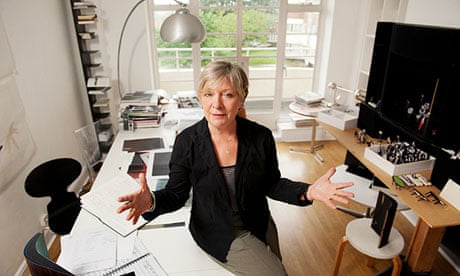What got you started?
We didn't have much when I was growing up, so from a young age, I was always making things: drawings of people, high-heeled shoes out of cardboard. I came from Germany to London to study painting at Camberwell, but was encouraged to go into stage design. I went on to Central St Martins, and things just fell into place: I'd seen some inspiring plays and knew I didn't want to be the kind of artist who spends a lot of time alone.
You started out designing for film. Why the move into theatre?
At first, I was upset about leaving film. If I hadn't had a young family and a busy actor husband [Bill Patterson], I'd probably still be doing it – but I'd been on location in Ireland for six months with my son, while my husband was filming in Italy, and it just seemed crazy. I thought that theatre would allow me to have a life. But it wasn't just about convenience: I love the fact that, in theatre, you are more in charge of the final image. You have the luxury of weeks to sit there contemplating your design.
Do you suffer for your art?
I have the odd sleepless night.
How has stage design changed?
Digital has altered everything: people are increasingly using video and digital images. This isn't a bad thing, but I still believe in some of the older practices, like building 3D models. They're the most fabulous tool.
Which of your designs has been the biggest challenge?
There are challenges in everything, from the tiniest to the largest space. Early in my career, I designed Coriolanus on a 45m-wide stage in Salzburg. We had 200 extras and several horses. That was pretty daunting.
You've won several awards. Is recognition important to you?
It seems important for careers these days. One of the first things people you haven't worked with before ask you is, "Can you tell me your awards?" I hate that: it's just like the star system for reviews, which I find so depressing. I don't actually think awards are good for you: there's always so much other work that deserves recognition.
Which artists do you most admire?
Picasso, for his total freedom when it came to experimenting. He was the driving force of the 20th century – and he did theatre design.
What work of art would you most like to own?
If my next pay cheque could stretch to it, I'd buy something by Callum Innes, the Scottish abstract painter. I love the depth of his paintings, their soft layers. I approach my own designs in a very painterly way.
What's the worst thing anyone ever said about you?
A reviewer once said my design for a production of King Lear at the National used "dull colours". That was quite a shock – colour really matters to me. It unnerved me for some time.
What advice would you give a young designer?
Persevere. There are so many more young designers out there than when I started out. If you're really passionate, you will make it happen.
CV
Born: Stuttgart, 1951.
Career: Has designed for major theatre and opera companies, including the National and the RSC, and for film and TV. Recent productions include Top Hat the Musical, for which she was Olivier-nominated; and Roots, opening at the Donmar, London WC2, 3 October.
High point: "When it all comes together: when you look round at a group of people and can't believe you've all got there."
Low point: "Periods when I haven't been so clever in my decision-making. One or two were definitely not right."

Comments (…)
Sign in or create your Guardian account to join the discussion